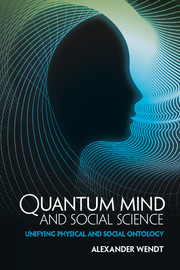Book contents
- Frontmatter
- Dedication
- Epigraph
- Contents
- Acknowledgments
- 1 Preface to a quantum social science
- Part I Quantum theory and its interpretation
- Part II Quantum consciousness and life
- Part III A quantum model of man
- Part IV Language, light, and other minds
- Part V The agent-structure problem redux
- Conclusion
- Bibliography
- Index
Part IV - Language, light, and other minds
Published online by Cambridge University Press: 05 May 2015
- Frontmatter
- Dedication
- Epigraph
- Contents
- Acknowledgments
- 1 Preface to a quantum social science
- Part I Quantum theory and its interpretation
- Part II Quantum consciousness and life
- Part III A quantum model of man
- Part IV Language, light, and other minds
- Part V The agent-structure problem redux
- Conclusion
- Bibliography
- Index
Summary
Introduction
I began Part III by describing what human beings are if we imagine them under a strict classical physics constraint, which is to say without reference to consciousness and therefore intentional properties. The resulting image is one of a machine or zombie – material, well-defined, subject only to local causation, deterministic, and, in effect, dead.
I argued that a very different picture emerges if we imagine ourselves under a quantum constraint with a panpsychist ontology. Quantum Man is physical but not wholly material, conscious, in superposed rather than well-defined states, subject to and also a source of non-local causation, free, purposeful, and very much alive. In short, she is a subject rather than an object, and less an agent than an agency, someone always in a state of Becoming. Moreover, this agency is a process in and through which she is sovereign. She decides her present by how she collapses her wave function (Chapter 8); she decides her future by projecting herself forward in time and enforcing correlations backwards (Chapter 9), and to some extent she even decides her past, by adding to or replacing it in her practices (Chapter 10). Of course, these decisions are not unconstrained, both internally and externally, but within those constraints the quantum model of man posits an irreducible freedom to create who we are. It is what I take to be an existentialist picture, in which our lives are like works of art.
I turn now in this and the next Part to the structural side of the agent–structure problem, which highlights not only the constraints but also the affordances in which human agencies are embedded. Some of these, like mountains and rivers, are purely material objects and as such external to human beings. To be sure, what those objects mean is interpreted and therefore can vary. To one person a mountain might be a sacred place to be revered, to another an obstacle to be blown up.
- Type
- Chapter
- Information
- Quantum Mind and Social ScienceUnifying Physical and Social Ontology, pp. 207 - 209Publisher: Cambridge University PressPrint publication year: 2015

